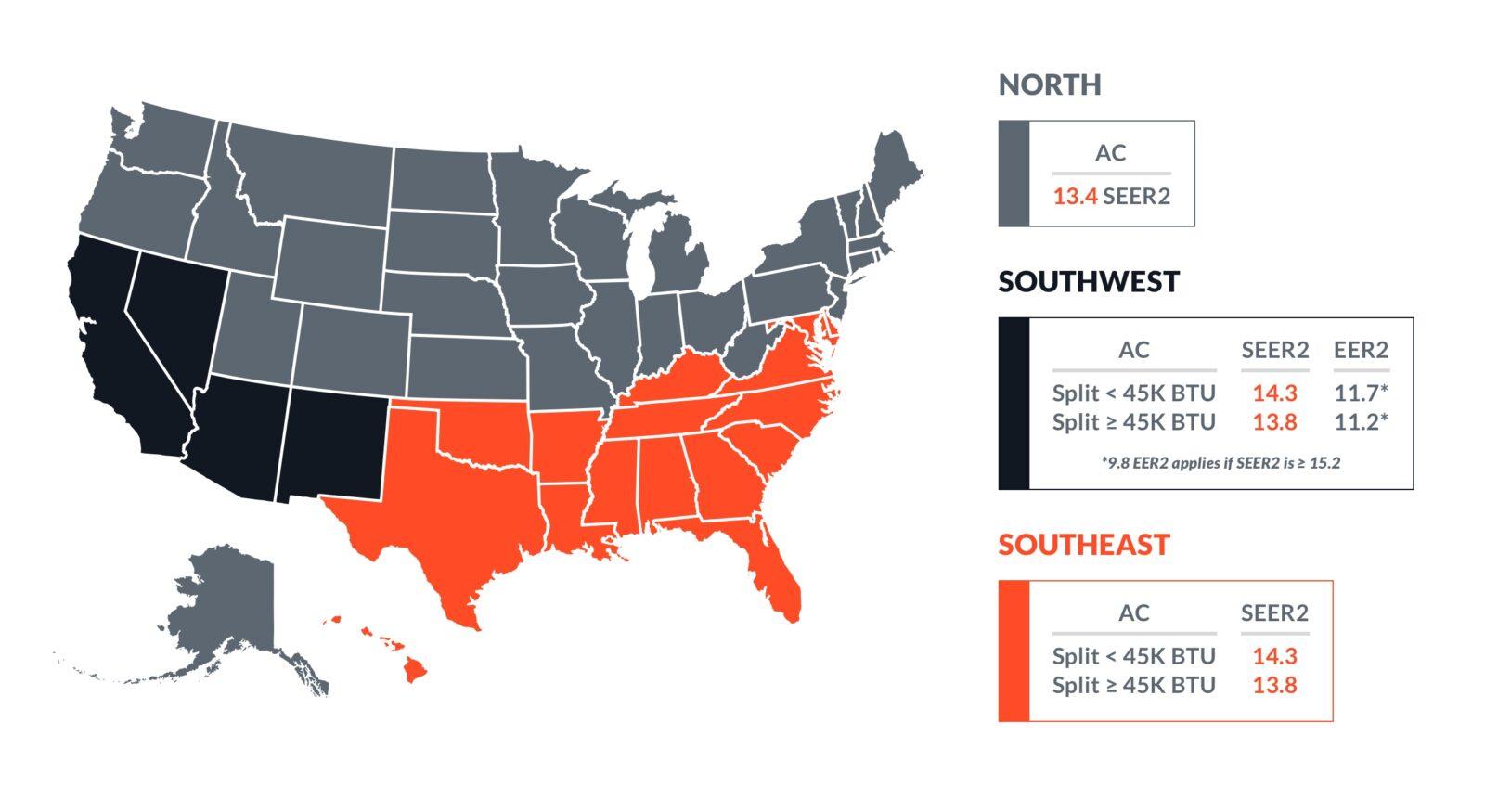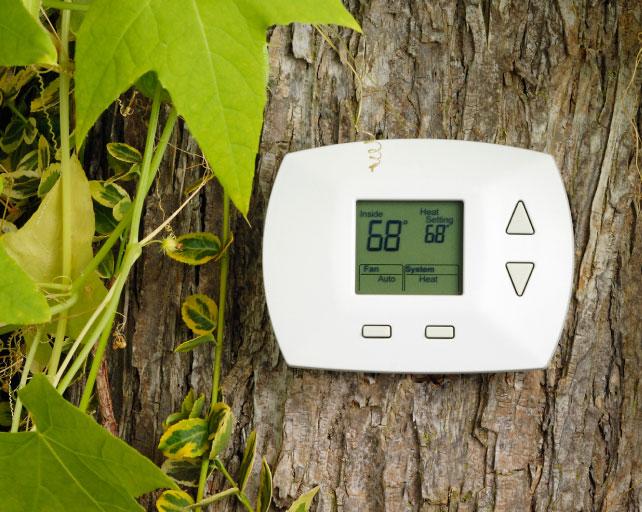Understanding HVAC Metrics: AFUE, BTU, EER2, HSPF2 & SEER2
Sorting through the alphabet soup of HVAC metrics doesn’t have to be hard. Read through our guide and you’ll understand these acronyms in no time.
By Anne Fonda
Every industry has its acronyms - but the HVAC industry may have more than most. Even the industry name is an acronym. HVAC stands for Heating, Ventilation, and Air Conditioning. While you may be familiar with the term HVAC, the other terms may be new to you.
Learn how understanding heating and cooling metrics can help you choose the right system for your home.
What Do Those HVAC Acronyms Mean?
The acronyms in the title relate to how energy-efficient heating and cooling units are. In this article you will learn what the acronyms mean, the importance of energy efficiency ratings, and how the ratings may have changed since the last time you thought about buying an HVAC system.
We’ll cover:
You’ll learn what all of these terms mean and how each metric impacts energy efficiency and cost savings.
2023 New Minimum Efficiency Requirements
On January 1, 2023, the U.S. Department of Energy (DOE) issued new minimum energy efficiency standards for HVAC equipment. The new standards vary by region. Before the change, various metrics for efficiency were SEER, EER, and HSPF. With the update, the ratings are now SEER2, EER2, and HSPF2.
In the article linked above, you can view charts comparing the new ratings to the old ratings, and showing what the equivalent ratings of new to old are. HVAC equipment undergoes various testing procedures to determine the efficiency ratings for each unit.
The new standards aim to lower energy use in the U.S. You can save energy and money by buying a more efficient HVAC system.
Cooling Efficiency Ratings
Our first two metrics, SEER2 and EER2 have to do with your cooling system’s efficiency. These ratings apply to central air conditioners as well as heat pumps. Heat pumps, of course, not only heat your home in the winter but also cool your home in the summer.

SEER2
SEER2 stands for Seasonal Energy Efficiency Rating. An air conditioner's efficiency changes depending on the outdoor temperature. Your AC is more efficient and uses less electricity on cool days, and is less efficient on hotter days as it works harder to keep your home cool.
SEER2 is a measure of the AVERAGE efficiency over a range of temperatures. Kind of like measuring your car's AVERAGE miles per gallon across a wide range of driving conditions (city + highway).
The higher the SEER2 rating, the more efficient the unit is. Depending on your usage, you can use less energy and save money on your cooling costs with a more efficient unit. The minimum SEER2 requirements on cooling units vary depending on where you live and may also vary based on the capacity of the unit.
SEER vs SEER2
As we mentioned, new energy efficiency regulations went into effect in January of 2023. The required SEER rating was lower before that. Today, in the North, all types of air conditioners must have a SEER2 of 13.4 or higher. (Equivalent to 14 SEER).
In the Southeast and Southwest, SEER2 ratings depend on the cooling system type and the system capacity. Depending on capacity, split system air conditioners must have a SEER2 rating of 13.8 to 14.3. (Equivalent to 14.5-15 SEER).
Split system heat pumps must have a SEER2 of 14.3 or higher in all regions, and single-packaged air conditioners and heat pumps in all regions must have a SEER2 of 13.4 or higher.
What is a good SEER2 rating?
The higher the SEER2 rating, the more efficient the unit is. The best SEER2 rating for your new air conditioner or heat pump will be based on where you live, the size and layout of your home, and other factors. The best way to answer the SEER2 question is to consult with an experienced HVAC professional.
EER2
EER2 stands for Energy Efficiency Ratio. It measures the energy efficiency of an air conditioner or heat pump when the outdoor cooling temperature is 95°F. We mentioned above that air conditioner efficiency changes depending on outdoor temperature.
EER2 measures your air conditioner’s cooling efficiency on a very hot day at 95 degrees. If you live in a very hot climate, EER2 can be more important than SEER2 because you will spend more time at those higher temperatures
What is EER2 vs SEER2?
EER2 and SEER2 evaluate cooling efficiency but use different temperature conditions.
EER2 measures an air conditioner or heat pump’s efficiency at the peak cooling need when the outdoor temperature is 95°F, the indoor temperature is 80°F, and the humidity is 50%. SEER2 is an average of efficiency over the entire cooling season when temperatures range from 65°F to 104°F. Most manufacturers will give you the SEER2 rating, but you can ask your local HVAC dealer about the EER2.
Heating Efficiency Ratings
Whether you’re considering furnace replacement or heat pump replacement, it’s important to understand the heating efficiency ratings of the equipment you’re considering. And if you’re replacing your entire HVAC system, you’ll want to work with your dealer who will choose a matched system that is published on the Air-Condtioning, Heating, and Refrigeration Institute (AHRI) website. This way, you will know that your system is rated to work together and will provide the best comfort.
A properly matched system will offer maximum energy efficiency and continuous comfort.
HSPF2
HSPF2 stands for Heating Seasonal Performance Factor. It measures how efficient your heat pump is at heating your home during the winter months.
HSPF vs HSPF2
This is another efficiency rating that was updated in 2023, with HSPF2 being the current version. The DOE requires split-system heat pumps to have an HSPF2 of 7.5 or higher, and all packaged heat pumps to have an HSPF2 of 6.7 or higher. As with SEER2 ratings, the higher the HSPF2 rating, the more efficient the heat pump is at heating.
What is the difference between HSPF2 and SEER2?
Since a heat pump both heats and cools, its efficiency is measured by both metrics. HSPF2 measures heating efficiency, while SEER2 measures cooling efficiency.
What is a good HSPF2 rating?
The full answer to this will depend on your home and where you live. You want a heat pump with a higher HSPF2 rating if you have colder temperatures for several months out of the year. If you live where temperatures plummet for weeks at a time, you may want to consider pairing the heat pump with a furnace in a dual-fuel system.
Choosing an electric heat pump with a high HSPF2 rating can save money on heating. This depends on electricity versus natural gas prices. It can also help reduce your carbon footprint.
AFUE
What does AFUE mean? AFUE stands for Annual Fuel Utilization Efficiency. It’s a heating efficiency rating that measures how efficiently your furnace or boiler converts fuel to heat. Again, the higher the AFUE rating, the more efficient the furnace is.
Furnaces or boilers have an AFUE rating expressed as a percentage. The percentage is how much of the fuel burned goes directly to heat your home. The remaining percentage is what gets lost or wasted. The current minimum AFUE allowed by the DOE for furnaces is 80%.
We list the AFUE rating for each unit on our furnace product pages. To make things even easier, we include the furnace AFUE in the product name. For instance, the 97 Two-Stage Variable-Speed Gas Furnace has an AFUE rating of 97%. Currently, it’s the most efficient furnace Trane makes.
To determine a furnace’s AFUE rating, HVAC professionals use this calculation:
AFUE = (Total annual heat output in BTUs / Total annual energy input in BTUs) x 100
Understanding BTUs
There’s another acronym. BTU stands for British Thermal Unit. A BTU represents the amount of heating or cooling output a system can provide. A larger number means the system will provide more cooling or more heating. It is important to install a system that is sized correctly for your home.
Getting too small of a system means your home may not be cool enough in the summer (or warm enough in the winter). A system that is too large may overwhelm the ductwork in your home, or will not dehumidify your home as well as a properly-sized system.
Trane products are independently rated AHRI and receive certification after testing. This helps ensure our equipment meets or exceeds efficiency standards and that you get a system that you can rely on to provide energy-efficient heating and cooling.
Considering HVAC Replacement?
Browse our HVAC equipment. You’ll see that each product page includes the efficiency ratings for that unit. You may also see information about pairing a cooling unit with an air handler or furnace for a compatible matched system. Our goal is to help you make an informed decision after exploring your options.
You can also refer to our pricing guide to get an idea of what your HVAC replacement cost might be. Interested in how much energy and money you could save by installing a new system? Check out this ENERGY STAR® calculator.
Work with the HVAC Experts
The best way to choose the best HVAC system for your home that meets or exceeds your energy efficiency requirements is to work with a Trane Comfort Specialist. Our local dealers are experts in the HVAC industry and can make product recommendations tailored to your needs and your home.
Anne Fonda, Content Writer
A Content Writer with Trane Technologies, Anne Fonda researches topics and writes for Trane® and associated residential HVAC brands. She works in collaboration with Trane Technologies subject matter experts, offering easy-to-understand, informative content on complex topics. Her goal is to help consumers make informed decisions on the products and services they need.
She has written for HVAC and other service provider websites for over 16 years. Before transitioning to web content writing, Anne had a 14-year stint as an award-winning journalist. She graduated cum laude from the University of Missouri-Columbia School of Journalism.
When she’s not working, Anne enjoys playing word games, reading, gardening, spending time with family, and visiting gardens and museums.
Expert review by Mark Woodruff, Senior Product Manager, Ducted Outdoor




